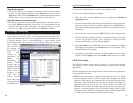
EtherFast
®
Cable/DSL Routers
2. Refer to “Appendix F: Finding the MAC Address and IP address for Your
Network Adapter” to verify that your computer has an IP Address, Subnet
Mask, Gateway, and DNS.
3. Set a static IP address on your system; refer to “Problem #1: I need to set a
static IP address.”
4. Refer to “Problem #10: I need to remove the proxy settings or the dial-up
pop-up window (for PPPoE users).”
5. I can’t get my Virtual Private Network (VPN) working through the Router.
Access the Router’s web interface by going to http://192.168.1.1 or the IP
address of the Router, and go to the Advanced => Filter tab. Make sure you
have IPsec pass-through and/or PPTP pass-through enabled.
VPNs that use IPSec with the ESP (Encapsulation Security Payload known as
protocol 50) authentication will work fine. At least one IPSec session will work
through the Router; however, simultaneous IPSec sessions may be possible,
depending on the specifics of your VPNs.
VPNs that use IPSec and AH (Authentication Header known as protocol 51)
are incompatible with the router. AH has limitations due to occasional incom-
patibility with the NAT standard.
Change the IP address for the Router to another subnet to avoid a conflict
between the VPN IP address and your local IP address. For example, if your
VPN server assigns an IP address 192.168.1.X (X is a number from 1 to 254)
and your local LAN IP address is 192.168.1.X (X is the same number used in
the VPN IP address), the Router will have difficulties routing information to
the right location. If you change the Router’s IP address to 192.168.2.1, that
should solve the problem. Change the Router’s IP address through the Setup tab
of the web interface. If you assigned a static IP address to any computer or net-
work device on the network, you need to change its IP address accordingly to
192.168.2.Y (Y being any number from 1 to 254). Note that each IP address
must be unique within the network.
Your VPN may require port 500/UDP packets to be passed to the computer that
is connecting to the IPSec server. Refer to “Problem #7, I need to set up online
game hosting or use other Internet applications” for details.
Check the Linksys website for more information at www.linksys.com.
71
Instant Broadband
™
Series
face of the Router. For example, if your WAN IP address is 1.2.3.4, you
would enter ping 1.2.3.4 and press the Enter key.
• If you get a reply, the computer is connected to the Router.
• If you do NOT get a reply, try the ping command from a different com-
puter to verify that your original computer is not the cause of the problem.
5. In the command prompt, type ping www.yahoo.com and press the Enter
key.
• If you get a reply, the computer is connected to the Internet. If you can-
not open a webpage, try the ping command from a different computer to
verify that your original computer is not the cause of the problem.
• If you do NOT get a reply, there may be a problem with the connection.
Try the ping command from a different computer to verify that your orig-
inal computer is not the cause of the problem.
3. I am not getting an IP address on the WAN with my Internet connection.
1. Refer to “Problem #2, I want to test my Internet connection” to verify that
you have connectivity.
2. If you need to register the MAC address of your network adapter with your
ISP, please see “Appendix F: Finding the MAC address and IP Address for
Your Network Adapter.” If you need to clone the MAC address of your net-
work adapter onto the Router, see the MAC Address Clone section of
“Chapter 8: The Cable/DSL Router’s Web-based Utility” for details.
3. Make sure you are using the right WAN settings. Contact your ISP to see if
your WAN connection type is DHCP, Static IP Address, or PPPoE (com-
monly used by DSL consumers). Please refer to the Setup section of
“Chapter 8: The Cable/DSL Router’s Web-based Utility” for details on
WAN settings.
4. Make sure you have the right cable. Check to see if the WAN column has a
solidly lit Link LED.
5. Make sure the cable connecting from your cable or DSL modem is con-
nected to the Router’s WAN port. Verify that the Status page of the Router’s
web interface shows a valid IP address from your ISP.
6. Turn off the computer, Router, and cable/DSL modem. Wait 30 seconds,
and then turn on the Router, cable/DSL modem, and computer. Check the
Status tab of the Router’s web-based utility to see if you get an IP address.
4. I am not able to access the Router’s web interface Setup page.
1. Refer to “Problem #2, I want to test my Internet connection” to verify that
your computer is properly connected to the Router.
70


















